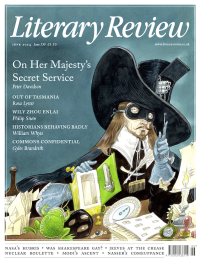Munro Price
Cabarets & Conspiracies
City of Light, City of Shadows: Paris in the Belle Epoque
By Mike Rapport
The Bridge Street Press 448pp £30
Alfred Dreyfus: The Man at the Center of the Affair
By Maurice Samuels
Yale University Press 224pp £16.99
Few places and periods in history conjure up such powerful images as Belle Epoque Paris: the cabarets of Montmartre, the glamour of the Grands Boulevards, the glories of Impressionism and Art Nouveau. Understandably, the era is often viewed through a haze of nostalgia, across the chasm of the First World War. Yet, as Mike Rapport makes clear in his splendid new book, the Belle Epoque was also a time of instability, upheaval and bitter division, in Paris and throughout France. Not only did the period end in a catastrophic war, but it also began with one: the Franco-Prussian War, in which France lost its northeastern provinces and which put in doubt its great-power status. Paris itself was besieged and briefly held by the Prussians. In the aftermath, a revolutionary socialist government, the Paris Commune, took power for a short time, but it was brutally crushed at the cost of thousands of lives. The Third Republic that rose from its ashes remains to this day the longest-lasting French regime since 1789, but it was racked by furious conflicts between Catholics and secularists, the army and the state, socialists and reactionaries. The cultural flowering of these years, which were also a time of periodic crisis and deep anxiety about the future, reached its apogee in Paris.
Rapport’s originality in City of Light, City of Shadows is to tell this story not simply chronologically, but through Paris’s buildings, locales and people as well. Having written books on cities and revolutions, including an excellent study of the upheavals of 1848, he is well qualified to do this. He is an erudite guide to the building of the Sacré Coeur and of course the Eiffel Tower, as well as the Paris Métro, which opened in 1900, and the great new department stores Printemps and Galeries Lafayette. Along the way, he takes in three contrasting quarters, representing the city’s immense diversity: the opulent Grands Boulevards between La Madeleine and the Boulevard de la Bonne-Nouvelle, the poverty-stricken district of Goutte d’Or and avant-garde Montmartre with its ‘paupers, artists and writers, Bohemians, crooks, squatters, and anarchists’. Weaving their way through the story are four emblematic figures: Emile Zola, the feminist Marguerite Durand, the visiting Vietnamese diplomat Nguyen Trong Hiep and the great socialist politician and orator Jean Jaurès.
The question Rapport poses is how such cultural vibrancy could go hand in hand with deep-seated political, social and cultural conflict. He finds the answer in modernity, defined as ‘the emergence of a new form of society from the profound … transformations in the Western world from the later eighteenth

Sign Up to our newsletter
Receive free articles, highlights from the archive, news, details of prizes, and much more.@Lit_Review
Follow Literary Review on Twitter
Twitter Feed
In 1524, hundreds of thousands of peasants across Germany took up arms against their social superiors.
Peter Marshall investigates the causes and consequences of the German Peasants’ War, the largest uprising in Europe before the French Revolution.
Peter Marshall - Down with the Ox Tax!
Peter Marshall: Down with the Ox Tax! - Summer of Fire and Blood: The German Peasants’ War by Lyndal Roper
literaryreview.co.uk
The Soviet double agent Oleg Gordievsky, who died yesterday, reviewed many books on Russia & spying for our pages. As he lived under threat of assassination, books had to be sent to him under ever-changing pseudonyms. Here are a selection of his pieces:
Literary Review - For People Who Devour Books
Book reviews by Oleg Gordievsky
literaryreview.co.uk
The Soviet Union might seem the last place that the art duo Gilbert & George would achieve success. Yet as the communist regime collapsed, that’s precisely what happened.
@StephenSmithWDS wonders how two East End gadflies infiltrated the Eastern Bloc.
Stephen Smith - From Russia with Lucre
Stephen Smith: From Russia with Lucre - Gilbert & George and the Communists by James Birch
literaryreview.co.uk